Explore our delicious salmon steak recipes—easy to make, full of flavor, and perfect for your next dinner!
Are you looking to elevate your dinner game with a dish that’s both healthy and flavorful? Salmon steaks are an excellent choice, offering a delicious and nutritious meal that’s easy to prepare.
With a variety of cooking methods to choose from, including roasting, grilling, pan-searing, and baking, you can create a salmon steak recipe that suits your taste preferences. Whether you’re a busy home cook or an adventurous foodie, these steaks are sure to become a favorite.
By incorporating salmon into your diet, you’ll not only enjoy a tasty meal but also benefit from the omega-3 fatty acids found in this nutritious fish.
Table of Contents
Key Takeaways
- Discover easy-to-make salmon steak recipes perfect for weeknight dinners or special occasions.
- Learn various cooking methods to prepare delicious salmon steaks.
- Explore different flavor profiles to suit your taste preferences.
- Understand the health benefits of incorporating salmon into your diet.
- Find adaptable recipes suitable for different dietary preferences and skill levels.
What Are Salmon Steaks?
Salmon steaks are a popular choice for many seafood lovers, but what exactly are they? Essentially, salmon steaks are cross-section cuts of salmon that include the bones and sometimes the skin. They are known for being more robust and having a better texture when cooked compared to fillets.
Salmon Steaks vs. Fillets
The main difference between salmon steaks and fillets lies in the cutting style. Salmon steaks are cut perpendicular to the spine, resulting in a piece that may include bones and sometimes the skin. In contrast, fillets are cut along the length of the fish, typically deboned and with the skin removed. This makes salmon steaks more forgiving when cooking, as the bones help retain moisture.
Nutritional Benefits of Salmon
Salmon is widely regarded as one of the healthiest foods available. As “brain food”, it’s packed with omega-3 fatty acids, high-quality protein, and various essential micronutrients. The omega-3 content in salmon has been linked to improved brain function and heart health. Regular consumption can help lower blood pressure and reduce the risk of heart disease. As a nutrient-rich fish, salmon provides numerous health benefits, making it an excellent addition to a balanced diet.
How to Choose and Prepare Salmon Steaks
To get the most out of your salmon steaks, it’s essential to choose and prepare them correctly. The quality of the salmon steak can significantly impact the final dish, making the selection process crucial.
Selecting Fresh Salmon Steaks
When selecting salmon steaks, freshness is paramount. Look for steaks with a vibrant color and a firm texture. Fresh salmon should have a mild smell; avoid any with a strong fishy odor. You can also check the packaging for any visible signs of damage or leakage.
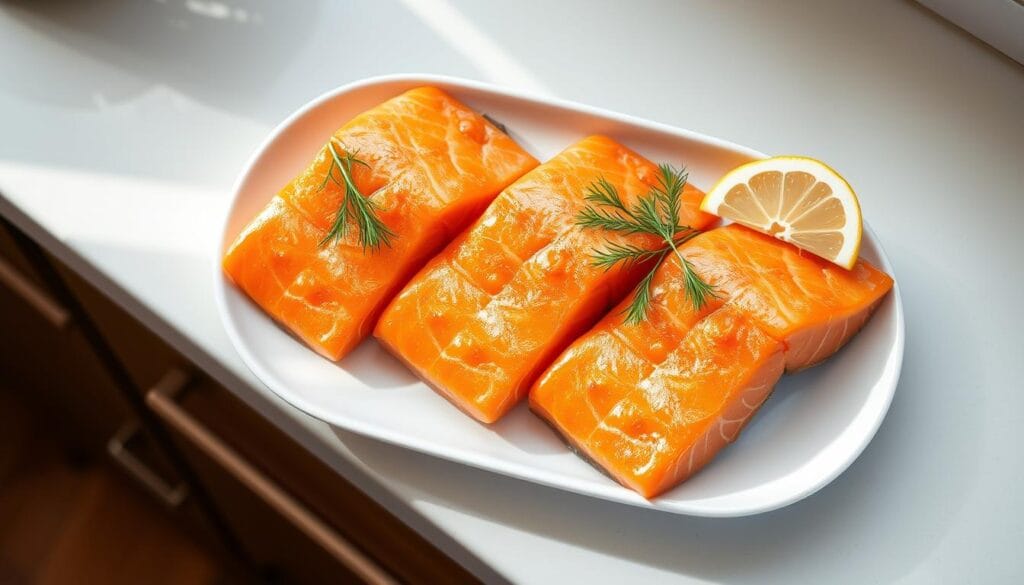
Removing Pin Bones
Before cooking salmon steaks, it’s crucial to remove the pin bones. These small, flexible bones can be unpleasant to encounter while eating. To locate them, gently run your fingertips over the surface of the salmon steak. Use fish bone tweezers or needle-nose pliers to remove the pin bones. As a quote from a seasoned chef goes,
“The key to a perfect salmon dish is in the preparation, and removing pin bones is a step you can’t skip.”
If you’re not confident, you can ask your fishmonger to remove them for you.
After removing the pin bones, rinse the salmon steaks under cold water and pat them dry with paper towels before proceeding with your recipe.
Essential Cooking Tips for Perfect Salmon Steaks
With the right cooking techniques, you can elevate your salmon steak dishes to a whole new level. Cooking salmon steaks to perfection involves more than just throwing them on the grill or in a pan; it requires attention to detail and an understanding of the key factors that influence the final result.
Ideal Internal Temperature
Cooking salmon steaks to the right internal temperature is crucial for food safety and quality. The ideal internal temperature for cooked salmon is between 145°F (63°C) and 150°F (66°C). Using a meat thermometer can help you achieve this temperature accurately. It’s essential to insert the thermometer into the thickest part of the steak to get an accurate reading.
How to Tell When Salmon is Done
Besides checking the internal temperature, there are other ways to determine if your salmon steaks are done. One method is to check for flakiness; cooked salmon should flake easily with a fork. You can also observe the color and texture; cooked salmon turns opaque and has a firmer texture compared to raw salmon.
Common Mistakes to Avoid
Several common mistakes can lead to subpar salmon steaks. Here are some pitfalls to watch out for:
- Failing to pat the salmon steaks dry before cooking, leading to sticking and poor searing.
- Overcooking, which results in dry, tough salmon.
- Flipping the steaks too frequently or too early, causing them to break apart.
- Not preheating the cooking surface properly, leading to uneven cooking.
- Using inappropriate utensils that can damage the delicate flesh.
- Seasoning too far in advance, which can draw out moisture.
To further illustrate the importance of proper cooking techniques, let’s examine a comparison of different cooking methods and their effects on salmon steaks.
| Cooking Method | Cooking Time | Result |
|---|---|---|
| Grilling | 4-5 minutes per side | Caramelized crust, moist interior |
| Pan-searing | 3-4 minutes per side | Crisp exterior, tender interior |
| Baking | 12-15 minutes total | Evenly cooked, less crispy exterior |
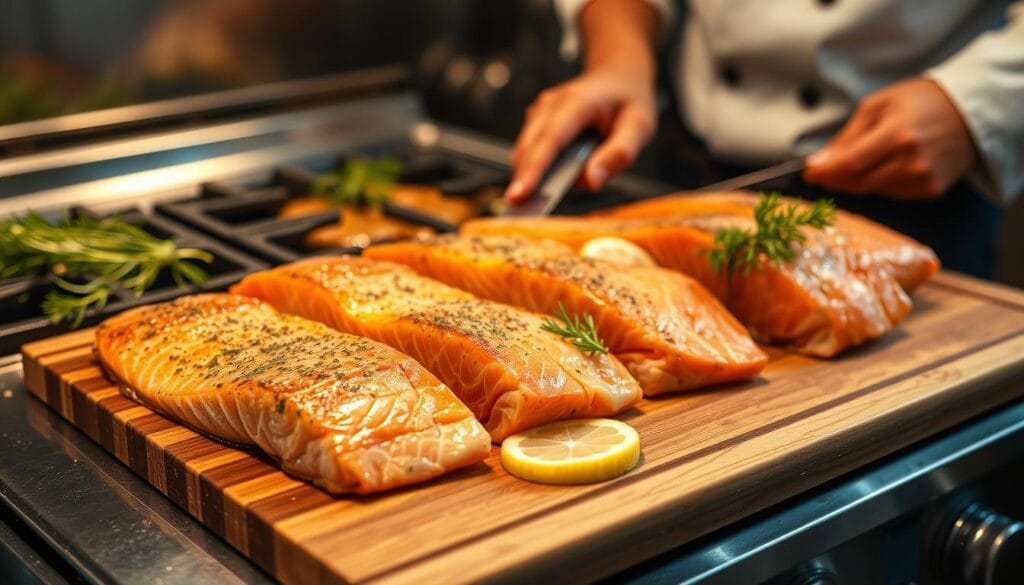
By avoiding common mistakes and following the right cooking techniques, you can achieve perfectly cooked salmon steaks that are both delicious and visually appealing. Remember, the key to cooking great salmon steaks lies in the details, from preparation to cooking.
Roasted Salmon Steaks with Lemon Butter Sauce
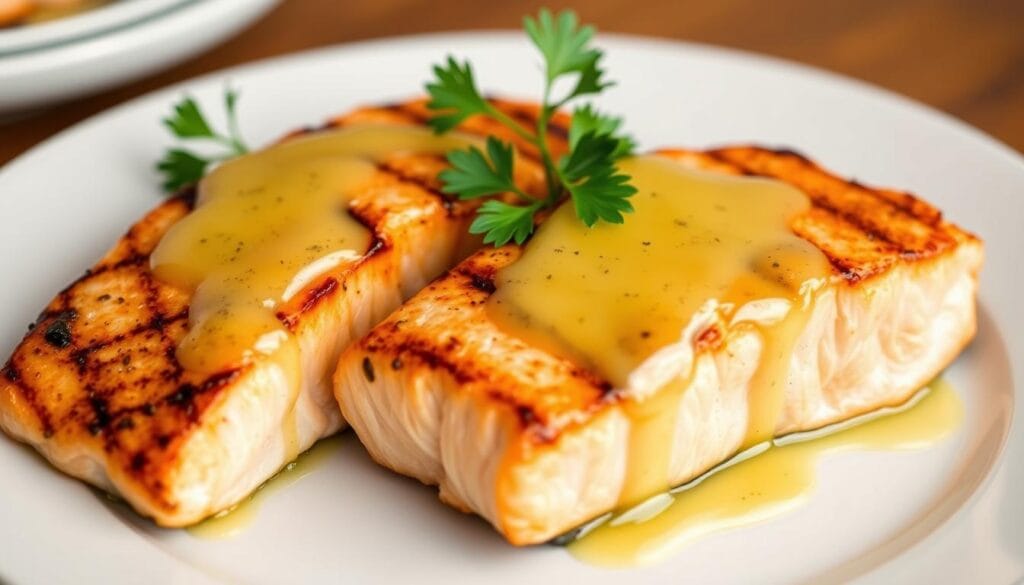
Indulge in a culinary delight with our roasted salmon steaks, perfectly complemented by a tangy lemon butter sauce. This dish is not only flavorful but also easy to prepare, making it ideal for a weeknight dinner or a special occasion.
Ingredients You’ll Need
To make this delicious recipe, you’ll need the following ingredients: salmon steaks, unsalted butter, fresh lemon juice, Worcestershire sauce, paprika, salt, and fresh ground pepper. Fresh herbs like parsley, basil, or tarragon are also recommended for garnish.
Step-by-Step Cooking Instructions
Preheat your oven to 400 degrees. Begin by buttering a large rimmed baking sheet or dish large enough to hold the salmon steaks in one layer. Arrange the steaks in the prepared dish. In a small saucepan, melt butter over medium heat. Once melted, remove from heat and whisk in lemon juice, Worcestershire sauce, and paprika. Season with salt and fresh ground pepper to taste. Liberally drizzle the sauce over the salmon.
Bake the salmon for 10 minutes per 1-inch of thickness, or until it reaches your desired doneness. Remove from the oven and let rest at room temperature for around 5 minutes. Transfer the steaks to individual serving plates or a serving platter. Drizzle with any remaining sauce from the baking dish and garnish with fresh herbs.
Serving Suggestions
Serve your roasted salmon steaks with simple sides that complement the delicate lemon butter flavors. Options include steamed asparagus, roasted Brussels sprouts, or a light arugula salad with lemon vinaigrette. For a more substantial meal, consider pairing with fluffy basmati rice, creamy mashed potatoes, or pearl couscous.
Grilled Salmon Steaks with Mustard Chive Sauce
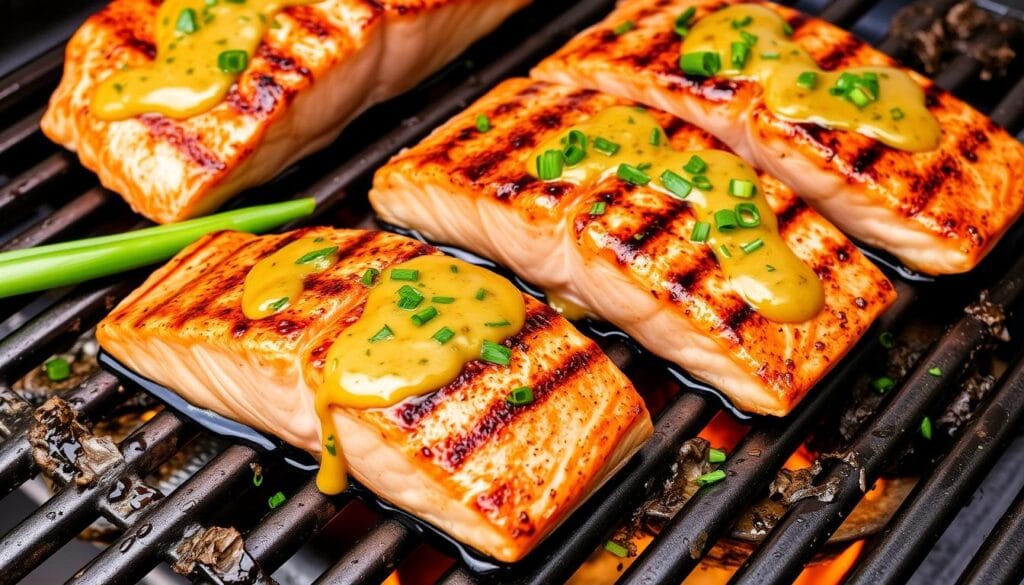
Elevate your summer grilling with our grilled salmon steaks recipe, featuring a tangy mustard chive sauce. This dish is perfect for outdoor gatherings and barbecues, offering a delicious and refreshing twist on traditional grilled salmon.
Ingredients You’ll Need
To make this recipe, you’ll need the following ingredients: salmon steaks, stone-ground mustard, Greek yogurt, fresh chives, honey, lemon juice, salt, and freshly ground black pepper. The combination of these ingredients will result in a flavorful and aromatic dish.
Grilling Technique
Preheat your grill to medium-high heat. Season the salmon steaks with salt and pepper. Grill the salmon for 4-6 minutes per side, or until it reaches your desired level of doneness. While the salmon is grilling, prepare the creamy mustard chive sauce.
Making the Creamy Mustard Chive Sauce
To make the sauce, combine stone-ground mustard, Greek yogurt, finely chopped fresh chives, honey, and fresh lemon juice in a small bowl. Whisk the ingredients together until smooth and well-incorporated. Season with salt and freshly ground black pepper to taste. For the best flavor, prepare the sauce at least 15 minutes before serving.
Maple Soy Grilled Salmon Steaks
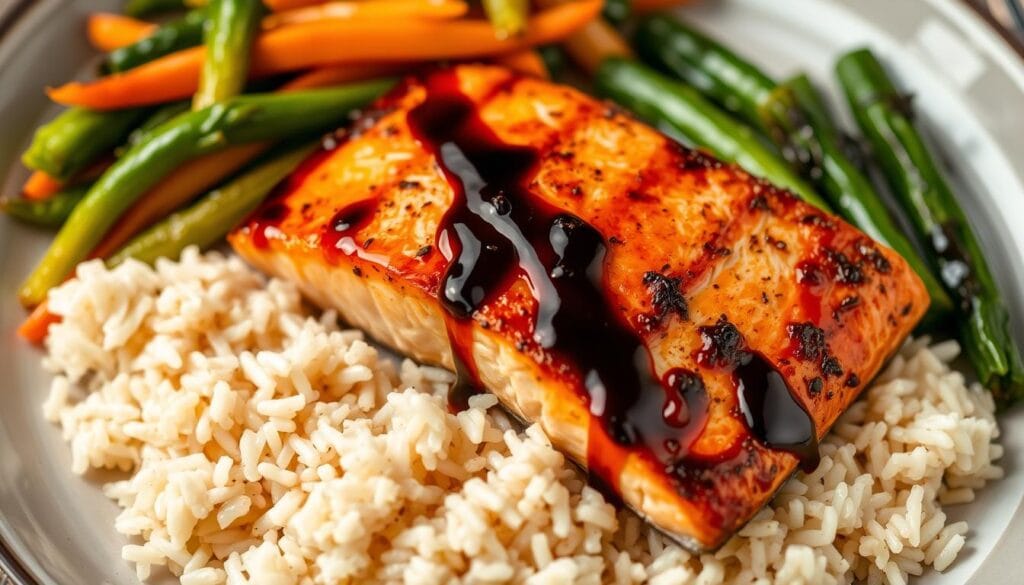
Maple Soy Grilled Salmon Steaks offer a sweet and savory twist on traditional grilled salmon. This dish is perfect for those looking to elevate their dinner game with a simple yet flavorful recipe.
Ingredients You’ll Need
To make Maple Soy Grilled Salmon Steaks, you’ll need the following ingredients: salmon steaks, maple syrup, soy sauce, garlic, ginger, and sesame oil. You can also add some green onions and sesame seeds for garnish.
Marinating and Grilling Instructions
Start by whisking together maple syrup, soy sauce, garlic, and ginger to make the marinade. Place the salmon steaks in a shallow dish and brush the marinade on both sides. Let it marinate for at least 30 minutes. Preheat your grill to medium-high heat and grill the salmon for 4-6 minutes per side, or until cooked through. Brush the salmon with sesame oil during the last minute of grilling.
Serving Ideas
Serve these maple-soy glazed salmon steaks on a bed of fluffy jasmine rice or coconut rice. You can also pair them with bright green vegetables like steamed bok choy or stir-fried sugar snap peas. For a colorful plate, add a carrot and red cabbage slaw with a ginger-lime dressing.
Alternative Cooking Methods for Salmon Steaks
Beyond grilling, there are several alternative cooking methods to prepare delicious salmon steaks. While grilling adds a smoky flavor, other techniques can provide equally mouth-watering results with different textures and flavors.
Pan-Seared Salmon Steaks
Pan-searing is a great way to achieve a crispy crust on your salmon steaks while keeping the inside moist. To pan-sear, heat a skillet over medium-high heat and add a small amount of oil. Season the salmon steaks with salt and your choice of herbs before placing them in the pan. Cook for about 3-4 minutes on each side, depending on the thickness of the steaks.
Baked Salmon Steaks
Baking is another excellent method for cooking salmon steaks, especially for those who are new to cooking fish. To bake, preheat your oven to 400°F (200°C). Line a baking sheet with parchment paper or aluminum foil for easy cleanup, and lightly grease it to prevent sticking. Arrange the salmon steaks on the prepared baking sheet, drizzle with olive oil, and season with salt, pepper, and herbs like thyme or parsley. You can also add slices of lemon and minced garlic on top for extra flavor. Bake for 15-20 minutes or until the salmon flakes easily with a fork.
| Cooking Method | Cooking Time | Tips |
|---|---|---|
| Pan-Seared | 3-4 minutes per side | Use medium-high heat and a small amount of oil. |
| Baked | 15-20 minutes | Preheat oven to 400°F (200°C) and season with herbs and lemon. |
Delicious Side Dishes to Serve with Salmon Steaks
Elevate your salmon steak dinner with these creative and flavorful side dish suggestions. Choosing the right accompaniments can enhance the flavor and texture of your meal, making it more satisfying and enjoyable.
Vegetable Sides
For a well-rounded meal, consider pairing your salmon steaks with a variety of vegetable sides. Roasted or sautéed vegetables can add a burst of flavor and color to your plate. You can try roasting fingerling potatoes with olive oil, rosemary, and garlic for a simple yet satisfying side dish. Alternatively, sautéed spinach or green beans with garlic and lemon can provide a light and refreshing contrast to the richness of the salmon.
- Roasted fingerling potatoes tossed with olive oil, rosemary, and garlic
- Sautéed spinach or green beans with garlic and lemon
Starch and Grain Accompaniments
When it comes to starch and grain accompaniments, there are numerous options to complement your salmon steak. A creamy risotto made with arborio rice, white wine, and finished with fresh herbs and a touch of lemon zest can provide an elegant base for your meal. For a healthier option, consider a quinoa pilaf with dried cranberries, toasted pine nuts, and fresh herbs, which adds protein, fiber, and a delightful textural contrast.
- Creamy risotto with arborio rice and lemon zest
- Quinoa pilaf with dried cranberries and toasted pine nuts
Storing and Reheating Leftover Salmon Steaks
To keep your salmon steaks fresh for a longer period, follow these simple storage and reheating tips. Proper storage is crucial to maintaining the quality and safety of your leftover salmon.
Refrigeration Guidelines
When storing leftover salmon steaks in the refrigerator, it’s essential to cool them down quickly and place them in a covered, airtight container to prevent moisture and other flavors from affecting the fish. You can store them in the refrigerator for up to 3 days.
Freezing Methods
For longer-term storage, you can freeze cooked salmon steaks. Wrap each steak individually in aluminum foil and then place them in a freezer-safe zip-top bag, pressing out as much air as possible before sealing. This method can extend the shelf life of your salmon steaks to 2-3 months. Consider portioning larger steaks before freezing for easier meal prep.
Conclusion
With a variety of cooking methods and flavor profiles at your disposal, you’re now equipped to create mouth-watering salmon steak dishes. We’ve explored a range of delicious salmon steak recipes that showcase the versatility of this magnificent cut of fish.
From the elegant simplicity of Roasted Salmon Steaks with Lemon Butter Sauce to the bold flavors of Maple Soy Grilled Salmon Steaks, these recipes demonstrate that cooking restaurant-quality salmon at home is accessible to cooks of all skill levels.
Whether you prefer the convenience of oven baking, the smoky char of grilling, or the precise control of pan-searing, there’s a cooking method that will suit your kitchen setup and culinary comfort zone. By understanding the fundamentals of selecting, preparing, and cooking salmon steaks, you’ve gained knowledge that extends beyond these specific recipes, empowering you to create your own variations.

